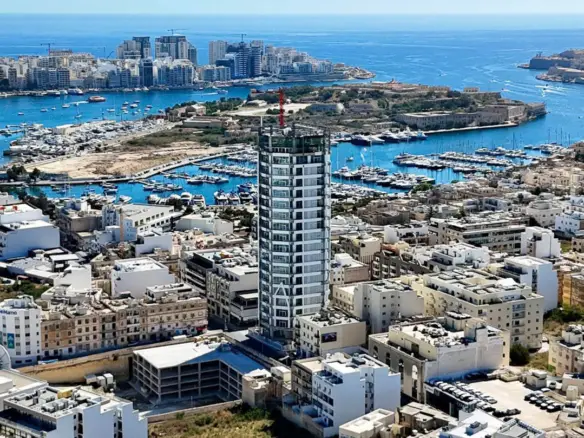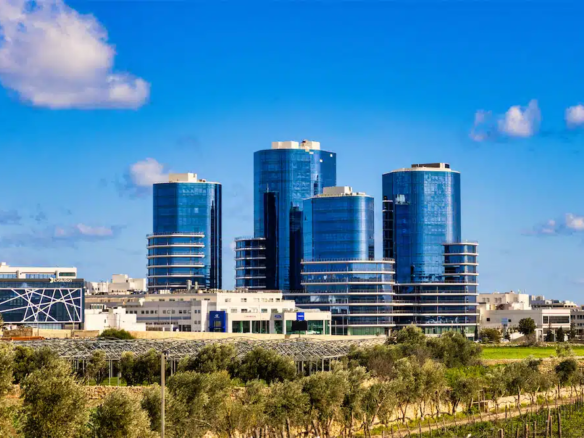In real estate, everyone says “location matters.” But in Malta, it matters even more. Space is limited, demand is concentrated, and geography isn’t negotiable-you can’t just shift the central business district across the island. For companies choosing an office here, location determines not only rent but also how easy it is to attract staff, impress clients, and run daily operations.
Being an island nation, Malta has natural limits. Roads are congested, parking is scarce, and public transport coverage varies significantly by district. Add to this EU environmental directives, rising energy costs, and the shift to hybrid work models, and you’ll find that the right office location is about more than square footage. It’s a decision with long-term financial and cultural consequences.
So, which areas are worth the premium? And which offer value without sacrificing convenience? Let’s break down Malta’s top office rental locations, from prestige hubs to cost-effective alternatives.
What makes a location “top tier”?
Before diving into specific districts, it helps to know the checklist that most decision-makers use.
- Accessibility: Is the office close to main arterial roads, bus routes, or ferry terminals?
- Infrastructure: Does the building have fibre internet, modern HVAC systems, and reliable power?
- Prestige: Does the address carry weight with clients? Valletta and Sliema still dominate here.
- Amenities: Are there cafés, restaurants, gyms, and shops within walking distance?
- Future-proofing: Is the area being upgraded with new transport or mixed-use developments?
Put simply:
| Factor | What to Look For | Why It Matters |
| Accessibility | Bus stops, ferries, arterial road links | Staff commuting and client visits |
| Infrastructure | Fibre internet, backup power, modern lifts | Operational stability |
| Prestige | Landmark streets or waterfront addresses | Branding, credibility |
| Amenities | Food, gyms, banking, shops nearby | Staff satisfaction and productivity |
| Flexibility | Lease terms, reconfiguration options | Adapting to growth or hybrid models |
Valletta & the Three Cities cluster
Valletta is Malta’s crown jewel. As the capital, it’s the centre of government and legal life. The Baroque architecture and UNESCO World Heritage status add prestige, but also practical challenges.
Strengths:
- Proximity to ministries, courts, and corporate HQs
- Heritage buildings with character and gravitas
- High foot traffic and visibility
Weaknesses:
- Parking is scarce; most staff rely on buses or ferries
- Narrow streets make logistics tricky
- Rent per square metre can be 20–40% higher than inland zones
Some firms-especially law practices, consultancies, and high-end financial services-accept these costs for the prestige alone. A Republic Street address on your letterhead signals authority.
The Three Cities (Birgu, Senglea, Cospicua) provide similar historic charm at slightly lower rents, though commuting can be tougher. They’re attractive for niche firms wanting character without full Valletta pricing.
Sliema / Gżira / Ta’ Xbiex / Msida corridor
This corridor is Malta’s commercial powerhouse. Offices here are modern, close to amenities, and well connected by road and ferry.
- Sliema: Retail and office hub, home to coworking spaces and high-footfall shopping streets. Popular with marketing agencies and iGaming firms.
- Gżira: Slightly cheaper than Sliema but rapidly upgrading, with plenty of mid-rise office developments.
- Ta’ Xbiex: Known for embassies, yachting marinas, and prestige office blocks with sea views. Favoured by finance, fintech, and maritime firms.
- Msida: More functional, cost-effective space, especially attractive to startups and back-office operations.
This belt offers the best mix of connectivity, amenities, and modern stock. The downside? High demand means limited availability, and rents for waterfront offices often rival Valletta’s.
Case example: A fintech firm moved from inland Birkirkara to Ta’ Xbiex. The rent doubled, but the prestige and accessibility helped them attract international partners and staff who valued a waterfront commute.
Birkirkara / Santa Venera / Qormi belt
Not every company needs a seafront address. Birkirkara and its neighbours form Malta’s inland commercial core.
- Strengths:
- Lower rents per square metre
- Excellent road connections (close to Regional Road)
- Larger floor plates suitable for logistics, call centres, or back offices
- Lower rents per square metre
- Weaknesses:
- Less prestigious than Valletta or Sliema
- Limited walkability and fewer lifestyle amenities nearby
- Less prestigious than Valletta or Sliema
This belt suits businesses that prioritise function and cost savings over prestige. A shared service centre or back-office hub can thrive here, reducing overheads while staying accessible by car.
Northern Corridor: St. Paul’s Bay, Mellieħa, Buġibba
These areas aren’t traditionally office zones, but hybrid work has changed demand patterns.
- Advantages:
- More spacious offices and newer builds
- Lower rents, often 20–50% cheaper than central Malta
- Coastal views and quieter environments
- More spacious offices and newer builds
- Drawbacks:
- Long commutes for staff living in central or southern Malta
- Less established business identity
- Long commutes for staff living in central or southern Malta
Some tech firms and creative agencies are experimenting with northern offices as hybrid hubs, offering staff living nearby a more convenient option. With remote work normalised, location prestige matters less than it used to-especially for firms without walk-in clients.
Special Zones & Business Parks
Beyond city centres, Malta has purpose-built zones designed for business.
- SmartCity Malta (Ricasoli): Originally pitched as a tech hub, now home to IT firms and international branches. Benefits include modern infrastructure, parking, and large-scale floor plates.
- Bulebel Industrial Estate: More industrial than corporate, but some firms leverage the space for back offices tied to logistics.
- Upcoming mixed-use developments: Projects combining offices with residential and retail are gaining traction.
These areas appeal to larger firms needing scalable, modern stock with lower fit-out costs. The trade-off is distance from the lifestyle amenities of Sliema or Valletta.
Comparing Malta’s top office locations
| Location Zone | Strengths | Weaknesses | Best Suited For |
| Valletta & Three Cities | Prestige, proximity to government | Parking, heritage constraints | Law, finance, consulting |
| Sliema / Gżira / Ta’ Xbiex | Modern stock, connectivity, amenities | High rents, congestion | Marketing, fintech, iGaming |
| Birkirkara / Santa Venera | Cost-effective, road hubs | Less prestige, fewer amenities | Back offices, logistics |
| Northern Corridor | Spacious, cheaper, quieter | Long commutes, less established identity | Hybrid firms, creative agencies |
| Business Parks & Special Zones | Modern infrastructure, scalable | Peripheral, lease rigidity | Scaleups, tech, export-oriented firms |
Trends in relocation and leasing in Malta
Malta’s office market is shifting under the influence of hybrid work. Large firms no longer lease sprawling floors “just in case.” Instead, many downsize their footprint in central zones and complement with smaller satellite hubs.
Trends worth noting:
- Hybrid work: Smaller central offices, supported by flexible coworking memberships.
- Gentrification: Secondary streets in Sliema are being revived as boutique offices.
- Redevelopment: Heritage buildings in Valletta being adapted into serviced offices.
- Amenities as value drivers: Offices near gyms, dining, and childcare options command higher loyalty.
For businesses, the key is to think long-term. A lease signed today should still make sense five years from now, even if hybrid models accelerate or EU sustainability standards tighten.
Tips for choosing your perfect office location in Malta
Finally, here’s a checklist to use when evaluating districts and specific buildings:
- Commuting times: Map where staff live and calculate average travel times.
- Public transport: Proximity to bus hubs or ferry terminals reduces reliance on parking.
- Parking availability: Still a critical factor in Malta, even with public transport improvements.
- Infrastructure readiness: Confirm fibre internet availability and backup power systems.
- Lease flexibility: Ask about reconfiguration options or expansion clauses.
- Prestige vs. function: Be realistic-does your business need a landmark address, or is cost efficiency more important?
- Future development: Check if the area has planned upgrades, such as new roads or commercial complexes.
Questions to ask landlords or agents:
- “Can you provide proof of fibre availability?”
- “What parking ratio is included in the lease?”
- “Are there heritage authority restrictions on renovations?”



